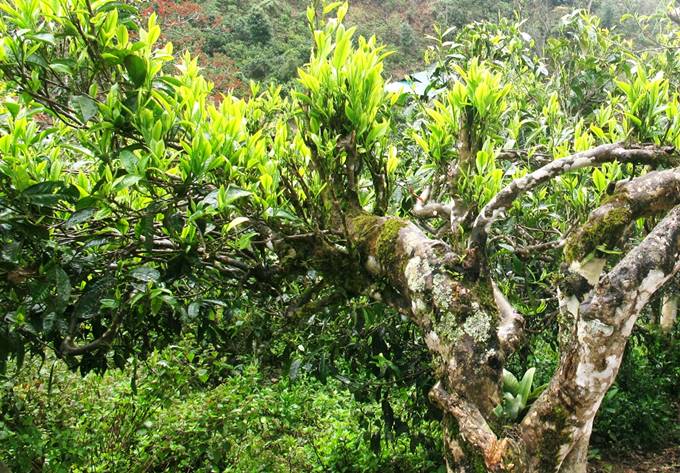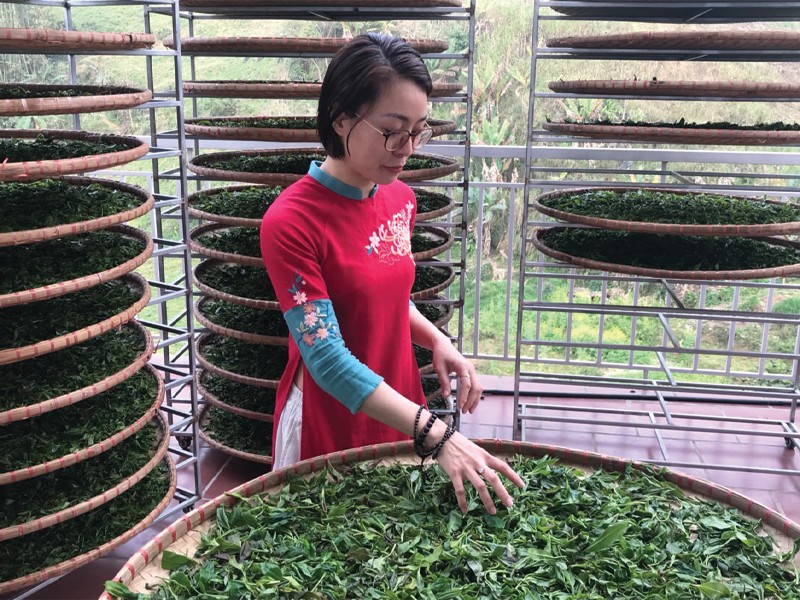Shan Tuyet tea is one of Vietnam’s most treasured tea varieties. It grows naturally in the high mountains of Northern Vietnam. This tea is prized not just for its rich flavor but also for the meticulous process that goes into harvesting and processing it. Each step, from picking the leaves to drying them, requires skill and tradition. The result is a tea that reflects the purity and majesty of the mountains where it is grown.

Harvesting Shan Tuyet Tea

The process of harvesting Shan Tuyet tea is an art in itself. The tea is picked by hand, usually by the ethnic minority communities who have been cultivating these tea trees for generations. These tea trees are ancient, often hundreds of years old, and they grow wild on the steep slopes of the mountains. The high altitude, cool climate, and misty conditions create the perfect environment for these trees to thrive.
Harvesting typically takes place in the early morning. The tea pickers set out at dawn, when the air is cool, and the leaves are still covered in dew. This dew is believed to contribute to the tea’s unique flavor. The pickers carefully select the youngest buds and the first few tender leaves. These are the parts of the plant that contain the highest concentration of flavor and nutrients. The harvesting process is labor-intensive, requiring both speed and precision. Each leaf must be plucked with care to ensure it remains intact, preserving the essential oils and delicate flavors within.
The harvested leaves are placed in baskets made of natural materials, which allow the leaves to breathe. These baskets are then transported down the mountain, where the processing begins.
Processing Shan Tuyet Tea

Once the leaves are harvested, the processing begins immediately to preserve their freshness. The processing of Shan Tuyet tea is a multi-step process that has been refined over centuries.
- Withering: The first step in processing Shan Tuyet tea is withering. The freshly picked leaves are spread out on bamboo trays and left to wither in the shade. This process allows the leaves to lose moisture and become more pliable for the next steps. Withering usually takes several hours, depending on the weather conditions. The goal is to reduce the water content in the leaves without losing their essential oils and aroma.
- Rolling: After withering, the leaves are gently rolled. This step is crucial as it helps to release the juices from the leaves, which are rich in flavor and aroma. Rolling also shapes the leaves into the distinctive curled form that is characteristic of Shan Tuyet tea. Traditionally, the leaves are rolled by hand, a technique that requires skill and experience. The rolling process must be done carefully to avoid damaging the leaves, which could result in a loss of flavor.
- Oxidation: Depending on the type of Shan Tuyet tea being produced, the leaves may undergo oxidation. Oxidation is what gives different teas their distinct characteristics. For example, green Shan Tuyet tea is minimally oxidized, retaining its fresh, grassy flavor. In contrast, black Shan Tuyet tea undergoes full oxidation, resulting in a rich, robust flavor. The level of oxidation is carefully controlled by the tea master, who monitors the leaves’ color and aroma throughout the process. This step can take anywhere from a few minutes to several hours.
- Drying: After rolling and oxidation, the leaves must be dried to stop the oxidation process and lock in the flavor. Traditionally, the leaves are dried over a wood fire, giving the tea a subtle smoky flavor. However, modern methods often involve drying the leaves in a controlled environment to ensure consistency. The drying process is crucial as it reduces the moisture content to below 5%, ensuring the tea can be stored without spoiling. The dried leaves are then sorted to remove any broken or inferior leaves, ensuring only the highest quality tea is packaged.
- Sorting and Grading: Once the leaves are dried, they are sorted and graded. The sorting process involves removing any stems or large pieces that do not meet the quality standards. The leaves are then graded based on their size, color, and appearance. The highest grade of Shan Tuyet tea consists of young, tender leaves that are covered in a fine layer of white hairs, giving the tea its characteristic “snowy” appearance. This grading process is done by hand, with experienced workers carefully selecting the best leaves.
- Final Firing: For some types of Shan Tuyet tea, a final firing step is added. This involves briefly heating the leaves to enhance their flavor and aroma. This step also ensures that any remaining moisture is removed, making the tea shelf-stable for a longer period. The final firing is done at a low temperature to prevent burning the leaves. The result is a tea that has a rich, complex flavor profile.
- Packaging: The final step in the process is packaging. The tea leaves are carefully packed into airtight containers to preserve their freshness. Packaging is done immediately after the final firing to ensure that the tea retains its full flavor and aroma. Some Shan Tuyet teas are also vacuum-sealed to extend their shelf life. The packaging is often done by hand, with great care taken to avoid damaging the delicate leaves.
The Unique Qualities
The careful harvesting and processing of Shan Tuyet tea result in a product that is truly unique. The tea has a distinct aroma, a deep flavor, and a lingering sweetness that sets it apart from other teas. The high-altitude growing conditions and traditional processing methods contribute to the tea’s complexity and richness.
Shan Tuyet tea is not just a beverage; it is a reflection of the culture and traditions of the people who produce it. Every step of the process, from harvesting to packaging, is done with care and respect for the land and the tea itself. This dedication to quality ensures that every cup of Shan Tuyet tea is a true taste of Vietnam’s mountainous regions.